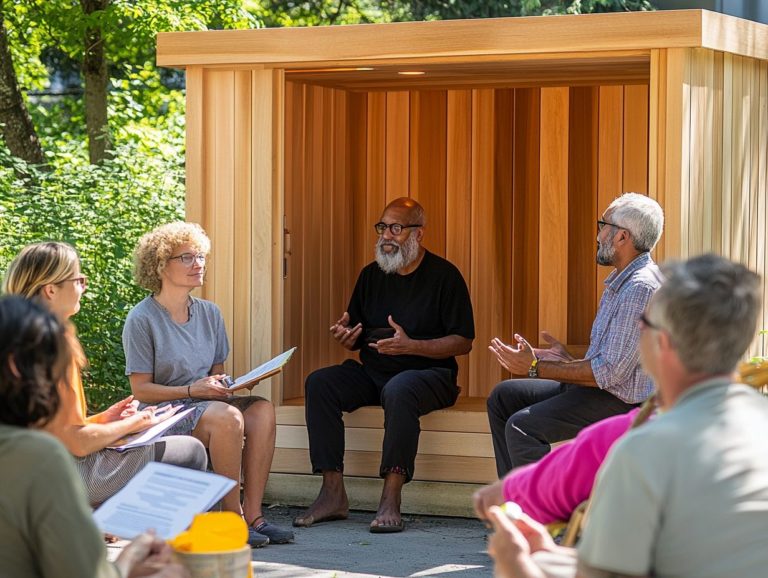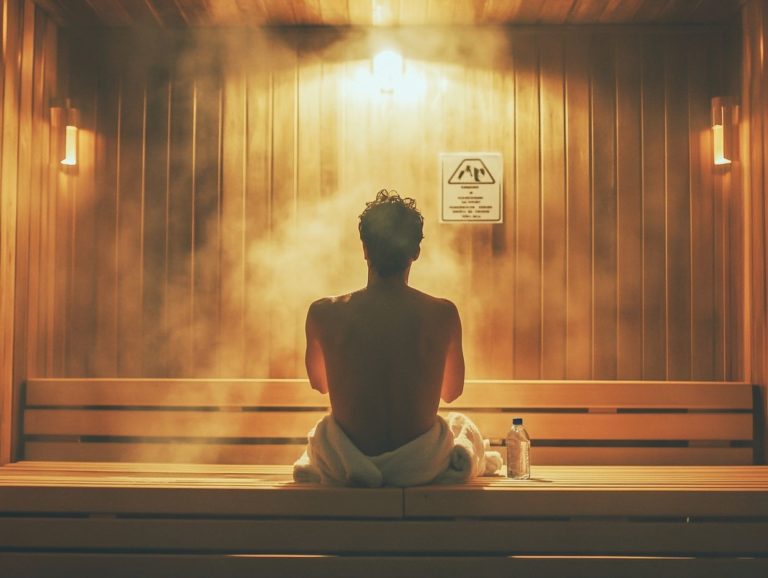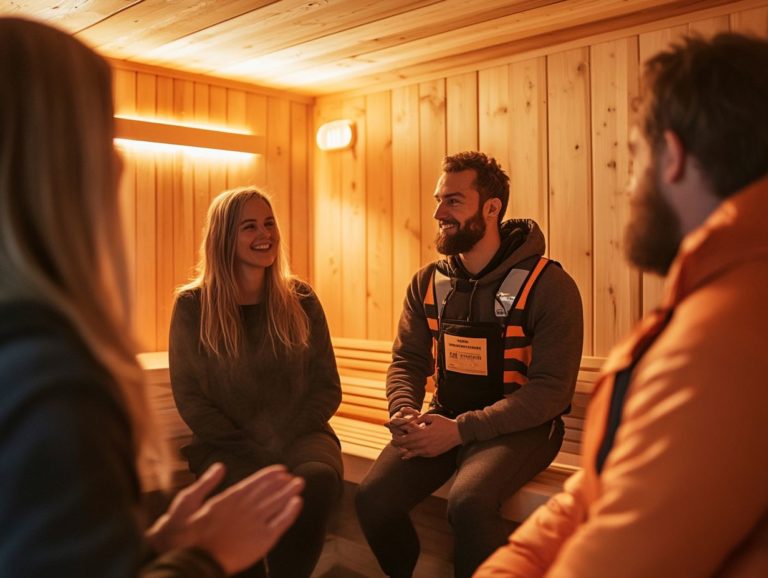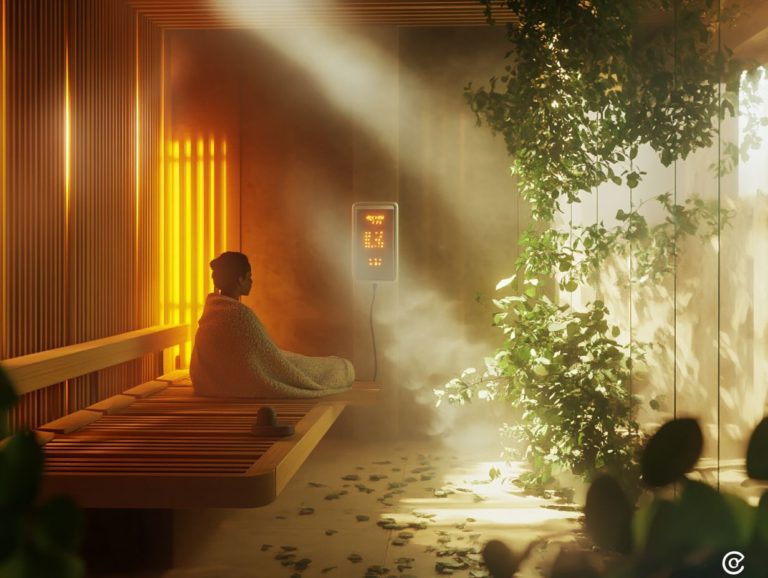Sauna Safety: Building Positive Relationships
Get ready to immerse yourself in the benefits of saunas while keeping safety and fun at the forefront! Saunas, particularly the renowned NZ Pop-Up Sauna along the Wellington waterfront, have long been celebrated for their soothing ambiance and a wealth of health benefits. From boosting your physical wellness to sharpening your mental clarity, these warm retreats can truly transform your overall well-being.
This article delves into everything you need to know about saunas from the physical and mental health benefits they provide to crucial safety precautions and etiquette that foster harmony in shared spaces, reinforcing the importance of community among sauna-goers.
You ll also find common myths debunked, empowering you to maximize your sauna experience, a key component in building positive communities. Dive in and discover how to embrace this ancient practice effectively and respectfully!
Contents
- Key Takeaways:
- The Benefits of Using a Sauna
- Sauna Safety Precautions
- Choosing the Right Sauna
- Proper Use of a Sauna
- Maintaining Positive Relationships in the Sauna
- Common Misconceptions About Sauna Use
- Frequently Asked Questions
- What is the importance of building positive relationships in a sauna?
- How can sauna safety be promoted through building positive relationships?
- What are some tips for building positive relationships in a sauna?
- Can building positive relationships in a sauna benefit my mental and emotional well-being?
- What should I do if I feel uncomfortable or unsafe in the sauna?
- Are there any specific guidelines for building positive relationships in a sauna?
Key Takeaways:

- Regular sauna use can have numerous physical and mental health benefits, making it a valuable addition to a wellness routine.
- To ensure safety in a sauna, it’s important to follow safety precautions and choose the right type of sauna for your needs.
- Maintaining positive relationships in the sauna requires practicing proper etiquette and respect for others in a shared space.
The Benefits of Using a Sauna
The benefits of using a sauna, particularly the renowned NZ Pop-Up Sauna along the Wellington waterfront, go well beyond simple relaxation; they embody a holistic approach to health, wellness, and community.
This distinctive sauna experience acts as a transformational space that offers a myriad of health advantages, including improved cardiovascular function, alleviation of symptoms of various conditions, and boosted emotional energy. To ensure a safe and enjoyable experience, it’s important to follow sauna safety guidelines. Such transformations promote positive community dynamics and reinforce social connections.
Drawing inspiration from Victor Turner’s principles, the ritualistic elements inherent in sauna use cultivate relationship building and foster a profound sense of common humanity among all participants. To ensure a safe experience, it’s important to follow sauna temperature guidelines for safety.
Physical and Mental Health Benefits
The physical and mental health benefits of using a sauna are backed by compelling scientific research, showcasing its ability to alleviate symptoms of various conditions like cardiovascular disease and psychotic disorders.
When you make regular sauna use a part of your routine, you’ll find it significantly improves detoxification, which helps your body eliminate harmful substances through increased perspiration. This age-old practice, rooted in ancient traditions where saunas functioned as both social and health hubs, has long been recognized for enhancing blood circulation, ultimately promoting a healthier cardiovascular system.
Research indicates that heat-induced dilation of blood vessels boosts overall circulation and aids in recovery from physical exertion. The serene atmosphere of a sauna enhances mental clarity, offering a tranquil retreat that helps reduce stress and encourages mindfulness. To ensure a safe experience, it’s important to follow sauna safety guidelines, which reinforces the sauna’s place in a holistic approach to your health and well-being.
Sauna Safety Precautions
When you indulge in the soothing experience of a sauna, especially in enchanting pop-up settings like the NZ Pop-Up Sauna on the Wellington waterfront, it s crucial to adhere to proper sauna safety precautions. This not only enhances your own experience but also ensures a beneficial and enjoyable time for everyone sharing the space.
Important Safety Measures
Important safety measures for your sauna experience include maintaining proper hydration levels and following recommended time limits to prevent overheating.
To truly maximize the benefits of your sauna sessions, it’s essential to stay hydrated before, during, and after use. Consider incorporating electrolyte-rich fluids to replenish what you lose through sweat. Always listen to your body; sensations of dizziness or excessive fatigue should prompt you to take a break or even end the session. Additionally, understanding the importance of encouragement in sauna safety can further enhance your experience.
Health professionals generally recommend limiting your sauna exposure to 15-20 minutes, especially if you have pre-existing health conditions like heart disease or high blood pressure. By being mindful of these hydration techniques and time guidelines, you can fully enjoy your sauna experience while embracing its therapeutic benefits safely. For more information, check out sauna safety: understanding your limits.
Choosing the Right Sauna

Selecting the perfect sauna is essential for enhancing both your health benefits and overall sauna experience. You have a variety of options, from traditional saunas that evoke a classic ambiance to modern infrared saunas. Each type presents unique features tailored to your distinct preferences and needs.
Types of Saunas and Their Features
Types of saunas include traditional ones, where cedar wood stoves heat the space, and modern infrared saunas, which use light to generate warmth. Each type boasts unique features tailored to diverse user preferences.
The heating method is a key distinction. Traditional saunas rely on heated rocks or stoves to warm the air, creating a steamy environment. In contrast, infrared saunas emit infrared rays, a kind of light that directly warms your body, allowing for a more comfortable experience even at lower temperatures.
In traditional setups, you ll typically encounter temperatures between 150 and 195 degrees Fahrenheit. Infrared models operate effectively at 120 to 140 degrees. This difference influences how quickly you can unwind during your session and affects your overall comfort. You can select a sauna style that perfectly aligns with your tolerance levels and health goals.
Proper Use of a Sauna
The proper use of a sauna is essential for ensuring a safe, enjoyable, and health-enhancing experience. By following best practices, you can enjoy all the benefits while minimizing any associated risks.
Best Practices for Using a Sauna
To make the most out of your sauna experience, focus on a few best practices: prioritize hydration, tune into your body’s signals, and manage your time inside for maximum comfort and benefits.
Start by ensuring you re well-hydrated before, during, and after each session. This simple step can help ward off dehydration, which often creeps in during extended heat exposure. Pay attention to any signs of discomfort dizziness, nausea, or excessive sweating. Recognizing these cues is essential for a safe and enjoyable experience.
Limit your time in a traditional sauna to about 15-20 minutes. If you’re using an infrared sauna, you might be able to extend your sessions a bit longer due to their lower temperatures. Remember, listening to your body is key, and if you have any pre-existing conditions, a quick chat with a healthcare professional can enhance your overall sauna journey.
Maintaining Positive Relationships in the Sauna
Maintaining positive relationships in the sauna is vital for cultivating a sense of community and mutual respect among your fellow sauna companions. This enriches your overall sauna experience and positions the sauna as a genuine hub for community building.
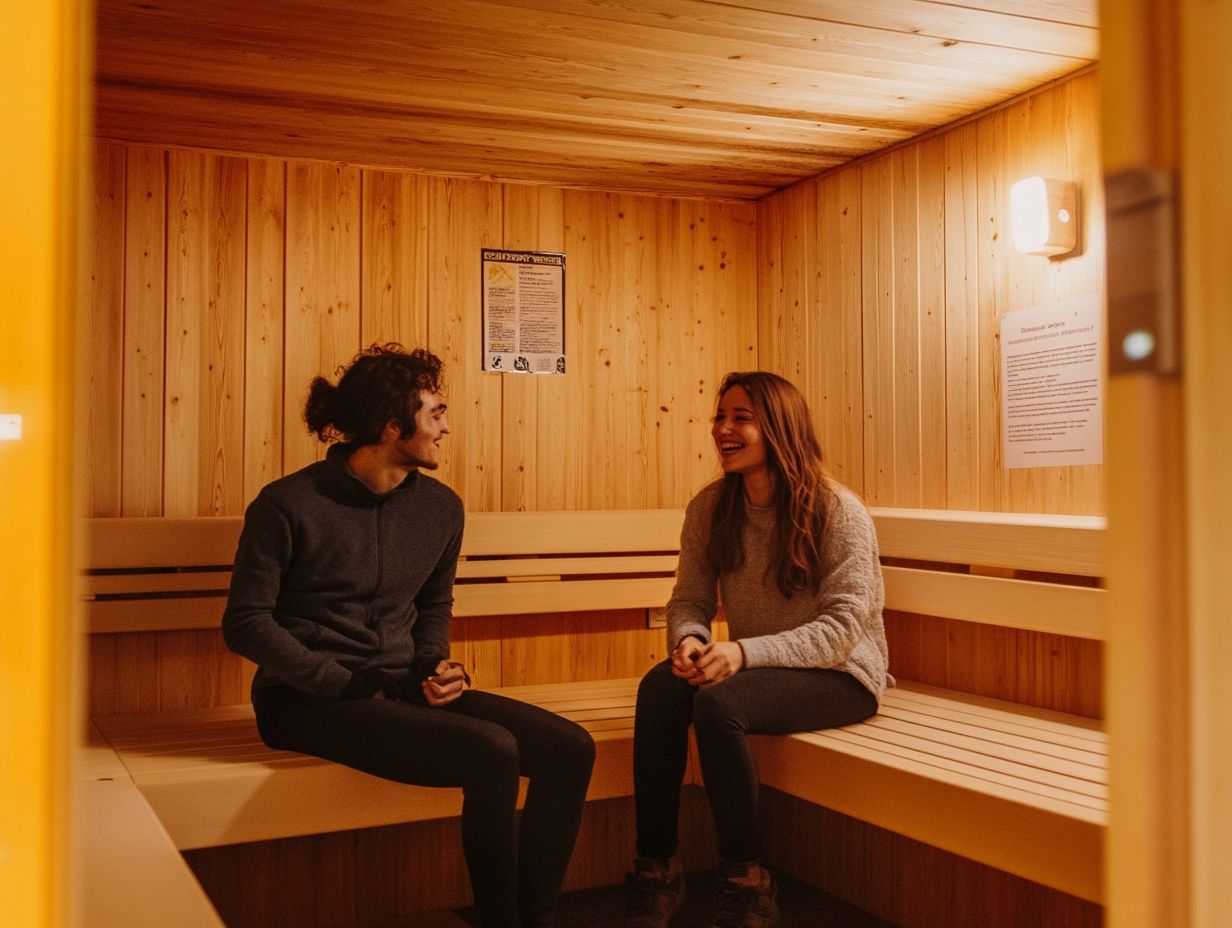
Sauna etiquette outlines the essential behaviors that contribute to a respectful and enjoyable atmosphere for everyone involved. It highlights the significance of mutual respect among your fellow sauna-goers.
By adhering to these guidelines, you can greatly enhance the communal experience. Be mindful of your noise levels, preserving a tranquil environment and engaging in quiet conversations only when absolutely necessary. Cleanliness should be your priority; as a regular user, make it a habit to wipe down benches after your session and avoid using oils or lotions that might leave behind unwanted residues. Additionally, it’s important to understand sauna safety to ensure a safe and enjoyable experience for everyone.
Respecting personal space is equally vital. Aim to sit at least one bench apart whenever possible to cultivate a comfortable and private setting. By following these principles, you can help foster a community that truly promotes relaxation and well-being for all, as emphasized in sauna safety and kindness.
Common Misconceptions About Sauna Use
Common misconceptions about sauna use frequently obscure the understanding of its genuine health benefits, resulting in confusion and misinformation regarding its effectiveness and safety.
It’s essential to navigate these myths and grasp the real advantages that saunas can offer for overall wellness. So, what are you waiting for? Dive into your sauna experience today!
Debunking Myths and Misinformation
Debunking myths and misinformation surrounding sauna use is crucial for fostering a clear understanding of its health benefits and proper practices, as well as highlighting their role in restorative justice conferences.
Many people hold misconceptions about saunas, believing they are solely for weight loss. In reality, sauna sessions can cause temporary weight loss through sweating. However, this is mainly water weight, not fat loss. Reputable studies show that regular sauna use can actually enhance hydration levels, provided you maintain adequate fluid intake.
Another prevalent myth is that saunas are only effective for muscle relaxation. However, they also play a significant role in heart health by improving circulation and potentially lowering blood pressure. Before diving into your sauna experience, it’s important to be aware of sauna safety. Understanding these facts empowers you to fully harness the positive effects of your sauna sessions while minimizing any potential risks.
Frequently Asked Questions
What is the importance of building positive relationships in a sauna?
Creating positive connections in a sauna makes the experience more enjoyable for everyone! It helps establish a sense of community and trust among sauna users.
How can sauna safety be promoted through building positive relationships?
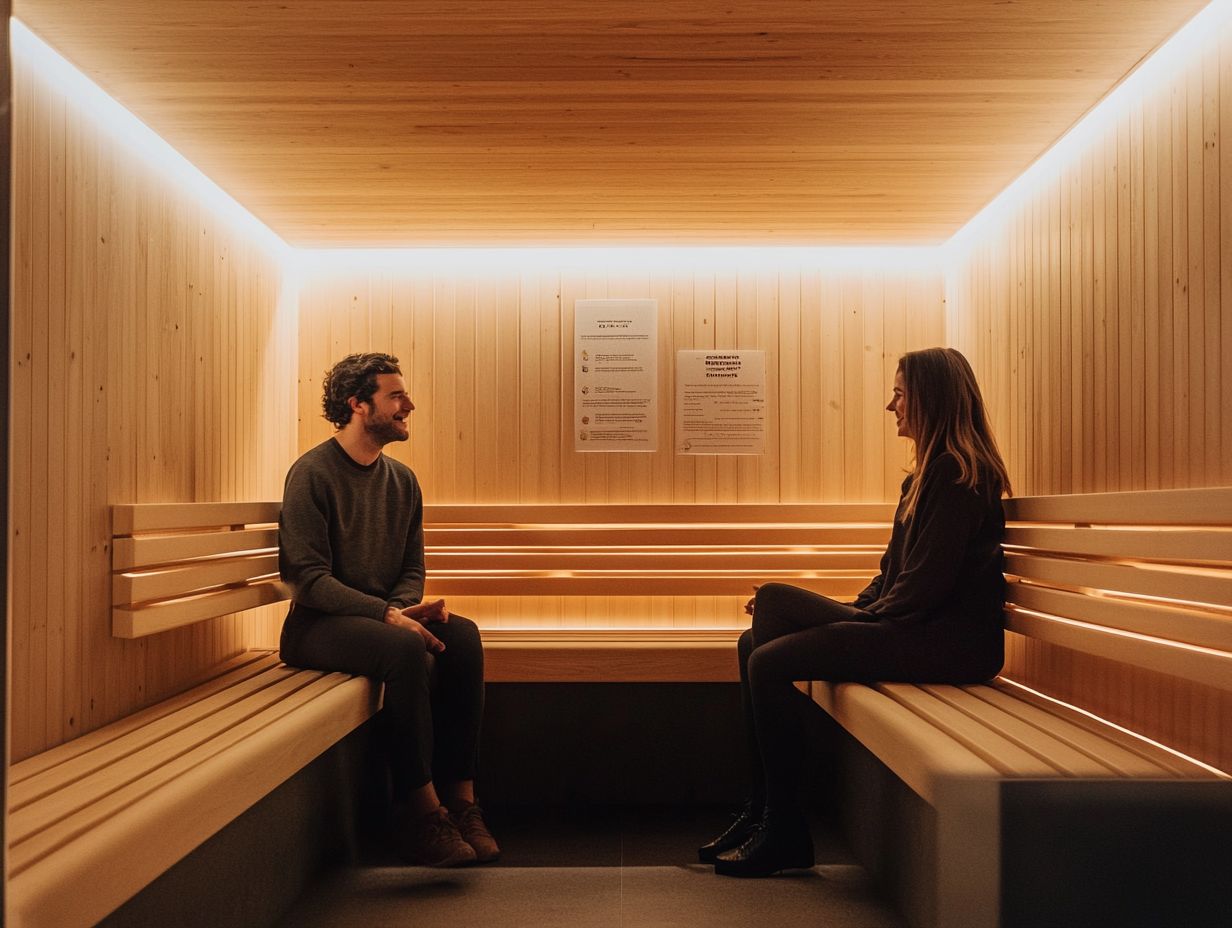
By building positive relationships with other sauna users, individuals can encourage and remind each other of important safety practices, such as staying hydrated and limiting sauna sessions to a safe duration.
What are some tips for building positive relationships in a sauna?
Some tips for building positive relationships in a sauna include being respectful of others’ space and privacy, engaging in friendly conversation, and avoiding judgment or criticism of others.
Can building positive relationships in a sauna benefit my mental and emotional well-being?
Yes! Building positive relationships in a sauna can contribute to improved mental and emotional well-being. It can provide a sense of belonging and support, and promote relaxation and stress relief.
What should I do if I feel uncomfortable or unsafe in the sauna?
If you ever feel uncomfortable or unsafe in the sauna, don t hesitate to speak up and communicate your concerns to the sauna host or other individuals present. It is important to prioritize your own well-being and safety.
Are there any specific guidelines for building positive relationships in a sauna?
While there are no set guidelines, it is important to be mindful of cultural and personal boundaries, avoid invasive or offensive behavior, and be open to learning and understanding different perspectives and backgrounds.


